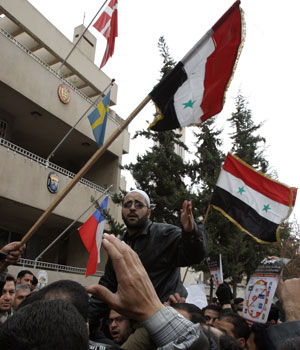
Syrian Muslims protest in front of the embassy of Denmark in Damascus over the publication of cartoons of the Prophet Mohammed deemed offensive to Islam, 02 February 2006 (AFP)
BAGHDAD, Iraq (AP) – Iraqi officials on Friday said 16 people were killed in two bombings launched minutes apart the day earlier in Baghdad that targeted a petrol station and a nearby market.
Just 20 minutes separated the two bombings, which took place Thursday in the capital’s eastern New Baghdad area.
Three Iraqis were killed after a bomb exploded next to a petrol station, while 13 more died when a suicide car bomber intending to attack a Shiite mosque was prevented by barricades, and chose the market instead, police Lt. Thair Mahmoud said.
“As he couldn’t get through (the barricades), he turned his car and slammed it into nearby shops and stalls,” Capt. Mohammed Jassim said.
Kindi Hospital medic Rahim al-Waili confirmed that 16 people were killed in the attacks, while more than 70 were also wounded.
Sunni and Shiite Islamic leaders across the country have called for demonstrations following Friday’s main weekly prayer services to denounce a set of caricatures of Islam’s Prophet Muhammad that were first published by a Danish paper in September.
They have since been reprinted in Norwegian, French, German and, even, Jordanian papers after Muslims condemned the images as insulting to their faith’s prophet.
The Danish newspaper, Jyllands-Posten, had asked 40 cartoonists to draw images of the prophet. The purpose, its chief editor said, was “to examine whether people would succumb to self-censorship, as we have seen in other cases when it comes to Muslim issues.”
Islamic law, based on clerics’ interpretation of the Quran and the sayings of the prophet, forbids depictions of the Prophet Muhammad and other major religious figures, even positive ones, to prevent idolatry. Shiite Muslim clerics differ in that they allow images of their greatest saint, Ali, the prophet’s son-in-law, though not Muhammad.
Tensions are also high in Baghdad’s predominantly Shiite Sadr City neighborhood following a Thursday U.S. helicopter attack that killed one woman and wounded three people. The helicopter fired rockets and guns after receiving gunfire from men on a roof, the military said.
Sadr City was the scene of fierce clashes between Shiite militiamen and American forces in 2004 and early 2005. The U.S. has recently pointed to the neighborhood as a model of improving relations between Americans and Iraqis.

An Iraqi soldier secures a busy street during a patrol in central Baghdad, 02 February 2006 (AFP)

Muslim students hold up signs calling on people to respect the holy figures and sanctuaries of Islam, over the publication of cartoons of the Prophet Mohammed deemed offensive to Islam, Saida, Lebanon (AFP)
